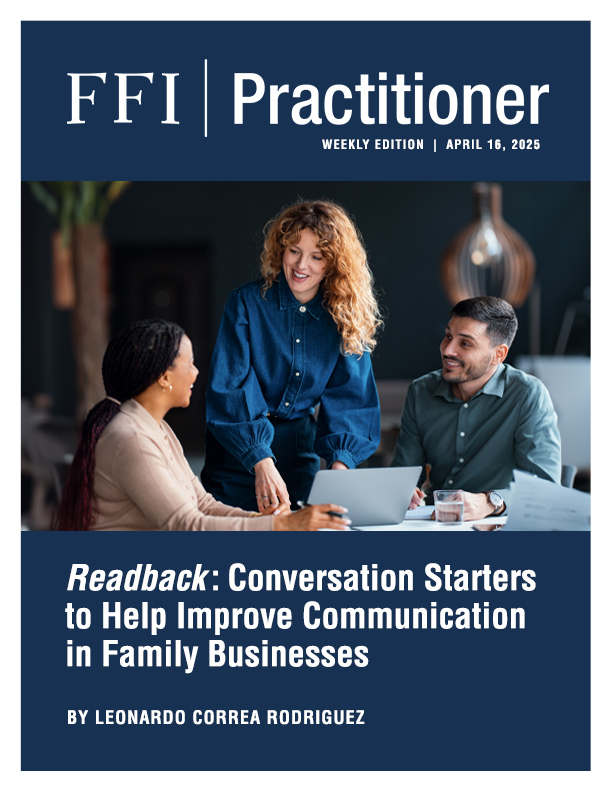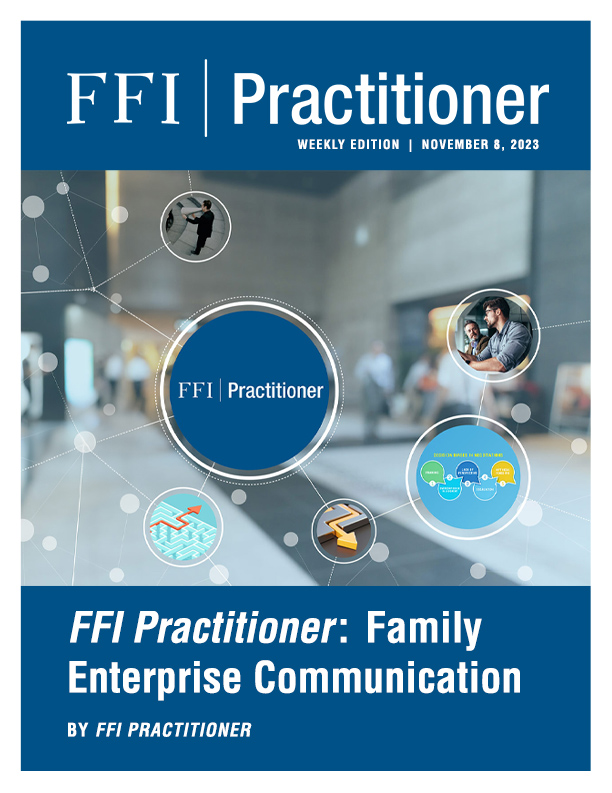
Today’s issue is a conversation starter about readback, a communication tool that is used in aviation, health care, coaching, and other professions—but is not that typical in family enterprise advising. Thanks to Leonardo Correa Rodriguez for providing this introduction to the practice, with examples of how readback can be deployed to avoid miscommunications and conflict within a family enterprise.
The Importance of Clear Communication
In aviation, clear and precise communication is crucial for safety. A small misunderstanding between a pilot and air traffic control can have serious consequences. To prevent errors, a technique called readback is used. This method ensures that the receiver of a message repeats what they have understood, confirming that the information has been accurately received and interpreted.
The concept of readback is not exclusive to aviation. In fact, it can be an invaluable tool in both family and business communication. Miscommunication is a common source of conflict in both personal and professional relationships. When individuals assume they understand each other without verifying, misunderstandings can lead to unnecessary disputes, inefficient decision-making, and even long-term resentment. In a multi-generation family enterprise where personal and professional relationships overlap, the stakes are even higher. Applying readback can significantly improve clarity, alignment, and trust among family members and business stakeholders.

Readback in Family Communication
Why Communication Breaks Down in Families
Families, like aviation teams, depend on effective communication to maintain harmony and coordination. However, messages often get distorted due to various factors:
- Assumptions: People tend to assume that others understand their perspectives, leading to incomplete or ambiguous communication.
- Emotions: Strong emotions can interfere with clear communication, causing individuals to misinterpret words based on their feelings rather than the intended message.
- Differences in Interpretation: Each person has their own way of processing information, which can result in different understandings of the same message.
By incorporating the readback practice into family communication, misunderstandings can be minimized, and relationships can be strengthened.
Benefits of Readback in Family Communication
- Reducing Conflicts: Many disagreements stem from one family member misinterpreting another family member’s communications. Confirming what has been understood can help clarify expectations and prevent unnecessary arguments.
- Enhancing Empathy: Repeating what another family member has said demonstrates active listening and consideration.
- Improving Decision-Making: Important family decisions—such as financial planning, education, and household responsibilities—require alignment to ensure smooth functioning.
- Parent: “We need to reduce unnecessary expenses this month.”
- Child: “So, you’re saying we should cut down on all expenses, including entertainment and dining out?”
- Parent: “Not entirely. I mean that we should be mindful of unnecessary spending, but we can still allocate a budget for essentials.”
Readback in Family Enterprises
In a family enterprise, effective communication is even more critical because the overlap of personal and professional relationships can complicate interactions. Business discussions are often influenced by emotions, past experiences, and personal dynamics, leading to misunderstandings that can impact both family harmony and business success.
Key Areas Where Readback Can Make a Difference
-
Strategic Alignment
- When family members are involved in the business as owners and employees, ensuring that everyone understands the company’s vision and mission is essential. Misinterpretations can lead to divergent strategies and conflicts.
Example:
- CEO (Founder): “We aim to expand into the international market within the next five years.”
- Son or Daughter (Shareholder): “So, if I understand correctly, our goal is international growth within five years. Does that mean seeking strategic partners or simply increasing exports?”
- CEO: “Good question. Our goal is to increase exports, but without compromising our current structure.”
Here, readback ensures that strategic goals are clearly defined and understood by stakeholders.
-
Decision-Making in Business Operations
- In a family business, decisions regarding investments, partnerships, and operational changes must be carefully evaluated. Readback can ensure that all parties fully understand the implications before proceeding.
Example:
- Operations Manager: “We should invest in new technology to improve efficiency.”
- CFO: “Thanks for sharing about the need to invest in new technology aimed at improving efficiency. Are you suggesting that we allocate a specific budget for this, or are you proposing a gradual upgrade?”
- Operations Manager: “I’m suggesting a phased upgrade over the next three years, starting with the most critical areas.”
This interaction clarifies expectations and ensures that financial planning aligns with operational needs.
-
Succession Planning
- One of the most challenging aspects of a family enterprise is preparing for leadership transitions. Ensuring that everyone understands succession plans and expectations can prevent conflicts and misunderstandings.
Example:
- Founder: “I want my eldest daughter to take over as CEO in five years.”
- Founder’s Youngest Son: “So, you mean in five years she will be the CEO while we continue to be involved in different capacities?”
- Founder: “Exactly. She will oversee daily operations, but all siblings will have roles based on their expertise.”
Here, readback helps clarify roles and responsibilities, reducing potential disputes over leadership transitions.
Sidebar
How to Implement Readback in a Family Enterprise
For readback to be effective, it must be practiced intentionally. Here are three key steps to implementing it successfully:
- Active Listening:
- Pay full attention to the message before repeating it. Avoid distractions and focus on the speaker’s words.
- Confirm and Clarify:
- Instead of simply repeating the message, ensure that it has been understood correctly by asking follow-up questions when necessary.
- Make It a Habit:
- Encourage the use of readback in key meetings, discussions, and decision-making processes. It can be particularly useful in board meetings, strategic planning sessions, and family councils.
Overcoming Challenges in Implementing Readback
While readback is a powerful tool, some family members may initially resist the practice, seeing it as redundant or unnecessary. Here’s how to address common challenges:
- Perceived Redundancy:
- Solution: Explain that readback prevents costly miscommunications and ensures alignment.
- Emotional Reactions:
- Solution: Foster a culture of patience and understanding, emphasizing that the goal is clarity, not criticism.
- Time Constraints:
- Solution: Use readback strategically in critical conversations rather than every minor discussion.

Conclusion
A family enterprise with clear, aligned communication is more likely to maintain harmony and achieve long-term success. Readback is a life tool that enhances understanding, reduces conflicts, and improves decision-making. By implementing readback in both family and business interactions, family members can ensure that their messages are heard, understood, and acted upon correctly, fostering a culture of clarity, trust, and collaboration.






